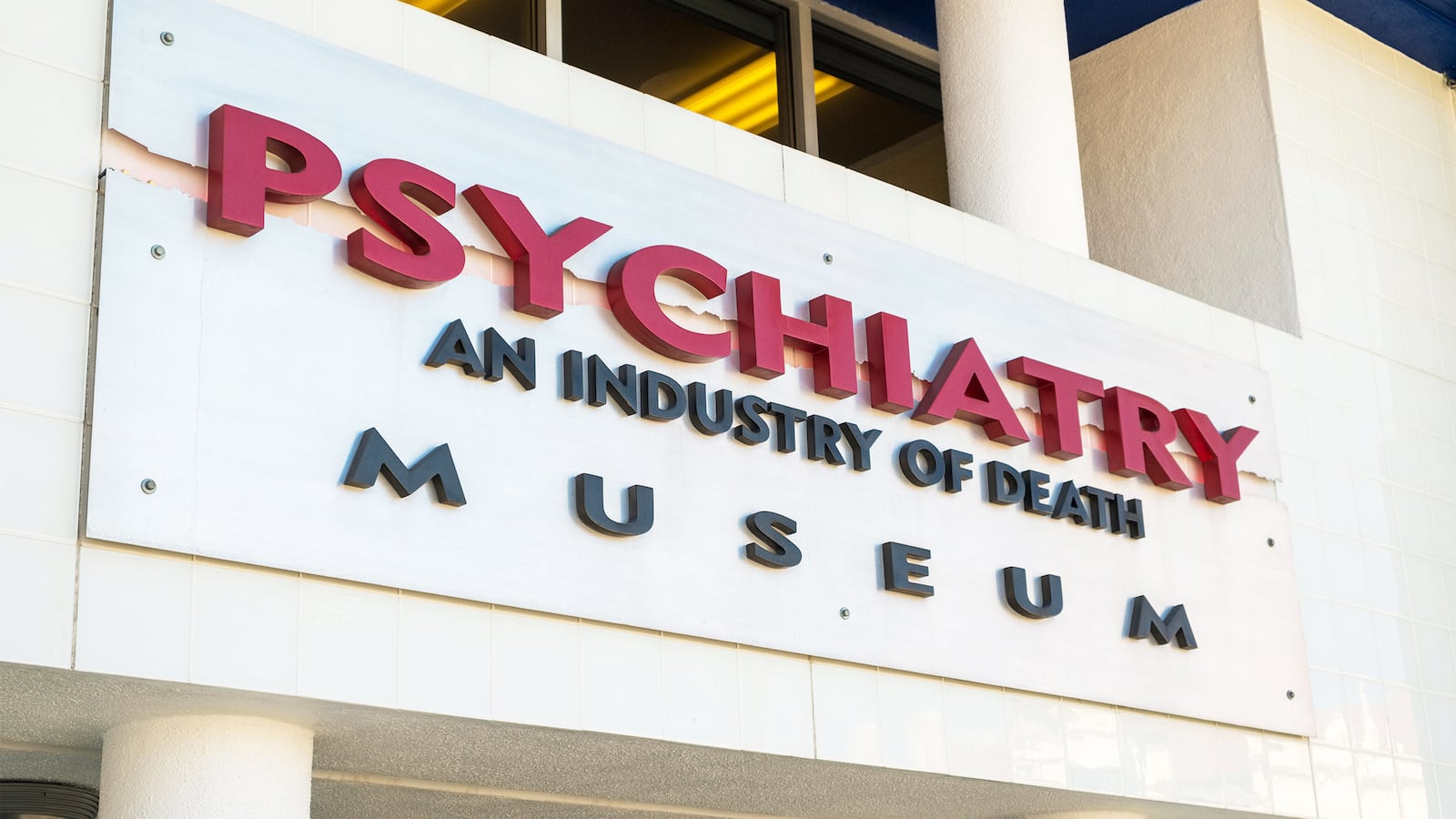LOS ANGELES, California—At 6616 Sunset Boulevard, a few blocks down from major L.A. landmarks like Amoeba Records and the Hollywood Palladium, there’s a white, sterile-looking building with modern angles and blue trim. At night, the place lights up like an ‘80s haunted house: backlighting posters of terrified faces, the crest of a shackled fist holding the scales of justice, and a red sign with Battlestar Galactica font, reading: “Psychiatry: An Industry of Death.”
This strange little multi-million-dollar museum, which is free and open to the public seven days a week, is the brick-and-mortar front of the Citizens Commission on Human Rights (CCHR), a “mental health watchdog” organization founded in 1969. The Commission was started by a Hungarian doctor named Thomas Szasz, author of a 1960 book called The Myth of Mental Illness. A virulent critic of psychiatry, Szasz spent his career arguing that mental illness was nothing more than a means of ostracizing outliers, and that treating it amounted to a kind of abuse. In his name, CCHR has spent 50 years lobbying against psychiatry by way of “investigating and exposing human rights violations in the field of mental health,” according to its website.
Since 1969, the organization claims to have been involved in passing more than 180 legal reforms in the psychiatry industry; it has allegedly given free tours to more than 250,000 people (70-80 percent of whom are students, one staff member estimated); and it boasts ties to the NAACP—one of their spokesmen, Rev. Fred Shaw, serves as vice president of the NAACP’s Inglewood/South Bay branch (Rev. Shaw declined to be interviewed). It is also—although the museum fails to note it anywhere prominently on the premises—entirely funded by the Church of Scientology.
When the museum debuted in 2005, the opening was attended by numerous high-profile Scientologists, including Leah Remini (who’s since left the church and spoken out against its alleged abuses), Jenna Elfman, Lisa Marie Presley, and Danny Masterson (who’s been accused by multiple women of rape). But a significant majority of the organization’s leadership and staff are also Scientologists (“Basically everyone,” an outreach coordinator said), including the high-ranking leadership and all five of the CCHR’s board of advisers.
Examining the tax forms of CCHR’s 23 different regional chapters, active and extinct, The Daily Beast identified a range of figures who have taken on leadership roles within the organization. There’s Clay Bock, a former candidate for city council in Orange County (and Scientologist) and high-profile Australian Scientology executive Jan Eastgate, who drew media attention in 2012 when she was charged with coaching an 11-year-old girl to lie about sexual abuse (the charges were later dropped). Another advisor, Canadian stock trader named Michael Baybak, was featured in a 1991 Time article on Scientology called “The Thriving Cult of Greed and Power,” which alleged that Baybak had made suspect trades to benefit church coffers (Baybak sued Time for libel and settled out of court; he was later dubbed a Scientology “Patron Excalibur” for his $15 million dollar donation in 2009). And advisor Isadore M. Chait, a prominent Asian art dealer who starred in a bizarre 2011 Scientology “squirrel baiting” video (wherein current members harass former members on tape), rose to minor infamy in the pages of The New Yorker, after selling Nicholas Cage a stolen Mongolian Tyrannosaurus rex skull. (None of these people responded to requests for comment.)

Actresses Anne Archer and Jenna Elfman attend the 'Psychiatry: An Industry of Death' museum opening on December 17, 2005, in Hollywood, California.
Kevin Winter/GettyIn a statement to The Daily Beast, a Church of Scientology spokesperson wrote that the church was “proud of what CCHR has accomplished in eradicating psychiatric abuses”; that the organization has been responsible for “life-saving reforms in mental health”; and that the museum “provides a fully documented and uncensored view of the history of psychiatry and its destructive practices.”
Scientology journalist Tony Ortega phrased it differently: “CCHR is interesting because it’s the most unhinged of the Scientology front groups. It openly advocates against psychiatry not because psychiatry might have some problems here and there—CCHR advocates detonating the entire modern mental health system. In fact, at one event ten years ago or something, [Scientology President David] Miscavige literally said that Scientology had ‘booby-trapped’ the psychiatric profession, and images of explosions were playing on the screen behind him.”
“This is the Inferno Door…”
On a recent evening, a wiry, blonde woman was manning the front desk in the museum’s bright, white lobby. Her name tag read Ruthie. As guests trickled in, she chatted politely, taking down names, occupations, and contact information. When everyone signed in, she escorted the group to a giant, medieval-looking door, painted like a prop from a Game of Thrones theme party. Above it, scrawled on a mantle of fake barbed wire, there was a famous quote from Dante—the one that starts with “Through me the way to the suffering city, through me the way to eternal pain” and ends with “Abandon every hope, ye who enter here.”
“This is the Inferno Door,” Ruthie said.
The Inferno Door opens up into a small, padded cell—clearly modeled after a mental institution. It’s a screening room for the museum’s 12-minute introduction video. What proceeds is not a documentary so much as an overlay of sepia images and news clips cropped too closely to make out full sentences. There’s an ominous voice-over too: “Everywhere you look—there it is,” a deep male voice says. “Think psychiatry has nothing to do with you? Think again.”
The Citizens Commission on Human Rights can be coy about what, exactly, it does. (“From its headquarters in Los Angeles, CCHR coordinates activities amongst its chapters around the world,” they write on their website.) But the museum is much less subtle. After the film, visitors file into a dimly-lit maze of exhibits with framed torture devices, belligerent wall text, and video testimonies from tear-stained victims. It’s a document of psychiatric misdeeds dating back centuries, with all the tact and fearmongering of a high school D.A.R.E. lecture.
They describe the Holocaust as “a psychiatric movement that would cause the deaths of millions…”
Some of the museum’s claims stem from legitimate concerns—spikes in antidepressant use, the overdiagnosis of ADHD, skyrocketing pharmaceutical costs, and historical tragedies, from lobotomies to racist experiments to abusive institutionalization. But the exhibits veer quickly and deeply into conspiracy. One panel charges 18th century physician Benjamin Rush, hailed by some as “the father of modern psychiatry,” with killing George Washington. Another writes off 9/11 as a plot from Osama bin Laden’s top aide, an Egyptian psychiatrist, in order to spur antidepressant sales in the newly traumatized American public. They describe the Holocaust as “a psychiatric movement that would cause the deaths of millions.”
The list goes on—school shootings, the Ku Klux Klan, apartheid, rape, segregation, slavery, plummeting test scores, torture, mind control, the death of art, literature and creativity—all, in the eyes of the CCHR, societal ills owed to mental health care. The way they see it, psychiatry and its practitioners manipulate people, diagnose them with problems they don’t have, and offer solutions that don’t work. Per their website, it is “an industry driven by profit, its pretended help often resulting in death.” They describe psychiatry, in other words, the way their critics describe Scientology.
The Scientology element is key to understanding the museum—not just because it is the primary economic, cultural and spiritual force behind it—but because it answers a question the exhibits themselves don’t exactly address: Why does this exist?

When L. Ron Hubbard first founded Scientology back in 1950, he conceived of it as a kind of competitor to psychology. Hubbard’s first Scientology book, Dianetics: The Modern Science of Mental Health, borrowed heavily from the writings of Sigmund Freud. It billed itself as “A Handbook of Dianetic Therapy’” identified “mental aberrations;” and it outlined the practice of “auditing,” where distressed patients would talk to professional counselors about their problems and feelings, in the hopes of reaching greater mental calm. At the time, Hubbard hoped that Dianetics would replace psychiatry, but the book only “evoked scorn,” University of Alberta sociologist Stephen Kent told Florida radio station WLRN in 2015. “By 1969, Hubbard had become so frustrated he went to war against the mental health professions.”
In the years since, the church has made many efforts to eradicate psychiatry whenever possible. After 9/11, for example, it launched the New York Rescue Workers Detoxification Project, a nonprofit aimed at helping first responders which promoted L. Ron Hubbard’s widely-criticized method of treating opiate addicts, called “Purification Rundown.” (Notably, it was the only charity Donald Trump’s foundation contributed to in the immediate aftermath of the attacks). The church launched Criminon International, a controversial program aimed at converting prison inmates, which highly discourages psychiatric drugs and mental health treatment among the prison population. It even allegedly broke up Tom Cruise and Nicole Kidman, in part because her father was a psychologist.
At no point in the museum does any exhibit explain what, exactly, the CCHR proposes as an alternative to psychiatric treatment. A page on the website briefs patients on their right to be informed and links to a few holistic medical clinics, alternative healing centers, legal resources, and drug addiction facilities. But it offers no clear solution for people suffering from mental problems. “We’re not allowed to recommend alternatives,” a school outreach coordinator who identified himself only as John said. “Because they’re not legally approved treatments.”
Scientology, however, has a history of proposing controversial alternatives to psychiatric treatment. In the 1970s, for example, Hubbard developed a treatment for psychotic patients that he called “Introspection Rundown.” It involved “putting a person who is having a psychotic break in isolation, making sure no one speaks to them,” Ortega told The Daily Beast. “This silent treatment is supposed to ‘cure’ serious mental illness. Instead, it has been a nightmare.”
“I wanted help. I wanted help.”
The most famous example of Introspection Rundown gone awry involved the death of a 36-year-old woman named Lisa McPherson. In the mid-1990s, McPherson, a converted Scientologist, got into a small car accident in Clearwater, Florida. After paramedics arrived on the scene, she began to strip off her clothes and parade around naked. When an EMT asked her why she had undressed, McPherson said, “I wanted help. I wanted help.” They rushed her to the hospital. There, clinicians attempted to bring her to a nearby psychiatric facility for an examination, but Scientologists protested. She was released into their custody and kept in isolation in a nearby hotel. Two weeks and three days later, McPherson died of dehydration. Newspapers reported that she had been denied water for 5-10 days.
McPherson’s death was a legal disaster for Scientology. The church was indicted on two felony charges and sued by McPherson’s family. The suit settled out of court and charges were later dropped but afterwards, the church did not stop administering Introspection Rundown. Instead, they shipped off cases to rural cabins, many in Tennessee. In 2017, one of those facilities, run by a Scientologist named Marc Vallieres, was closed by a local Sheriff’s department when a man called 911 and claimed he had been held there against his will for nine months. Two of the facility’s managers pleaded guilty to two counts of false imprisonment. Vallieres, charged with two facilitation-to-kidnapping felonies, pleaded no contest.
“So, while Scientology has CCHR trying its best to advocate against the psychiatric profession,” Ortega told The Daily Beast, “it repeatedly has disastrous results trying to deal with mentally ill people using its own methods.”
An earlier version of this article misidentified a former CCHR employee.



